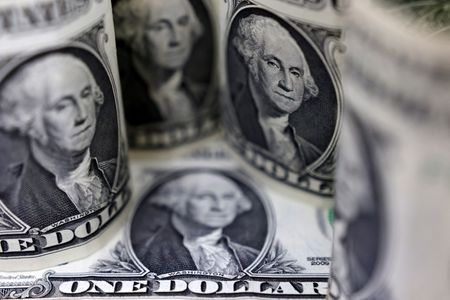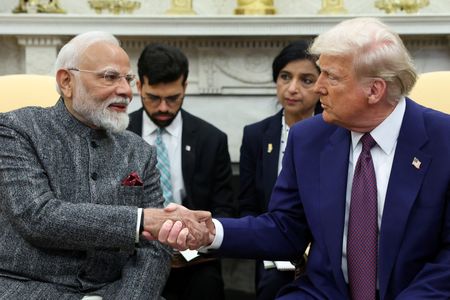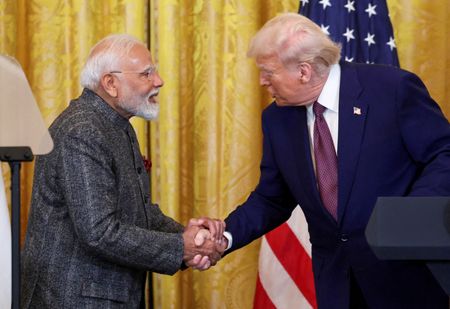By Jaspreet Kalra, Nikunj Ohri and Bharath Rajeswaran
MUMBAI (Reuters) -India’s rupee plunged toward a record low and equity indexes declined on Thursday after U.S. President Donald Trump slapped steeper-than-expected tariffs on Indian goods, with analysts warning of sustained pressure on the country’s growth.
The 25% tariffs announced could shave off the South Asian nation’s growth in 2025-26 by up to 40 basis points, with the threat of additional penalties further clouding the outlook, economists said.
India’s benchmark equity indices, the Nifty 50 and BSE Sensex, fell about 0.6% each, while the rupee declined to an over five-month low of 87.74 before paring losses amid likely dollar-selling intervention by the central bank.
The rupee is within touching distance of the record low of 87.95 it hit in February.
“88.00 looms as a big level on the charts and likely a focus for RBI as well,” said Brad Bechtel, head of global FX at Jefferies.
“Will be interesting to see if they allow the currency to depreciate through that level to offset the impact of tariffs or if they fight to maintain currency ‘stability’. I think they let it go through, in which case 90 becomes a big level to watch.”
IMPACT ON GROWTH AND INVESTMENT
Analysts warned that a dent to New Delhi’s manufacturing ambitions could hamper growth in the world’s fifth-largest economy.
“If these tariffs remain in place, they could undermine India’s growing appeal to businesses seeking trade diversion in low-value-added manufacturing sectors,” said Raphael Luescher, Co-Head of EM equities at Vontobel.
Goldman Sachs economist Santanu Sengupta estimated a 30-bps hit to growth once the tariffs are imposed, adding that “elevated policy uncertainty in the U.S. can cause Indian firms, particularly those exposed to U.S. tariffs, to postpone investment decisions.”
However, DBS Bank said downside risks are likely to be offset by fiscal support for labour-intensive industries and smaller exporting firms, alongside further rate cuts.
“Despite limited tariff arbitrage, we are still of the view that the economy will continue to benefit from trade diversion flows as manufacturers diversify and derisk from other production bases, including China,” DBS economists wrote.
GEOPOLITICAL BALANCING ACT
Alison Shimada, head of Total Emerging Markets Equity at Allspring Global Investments, said the direct macroeconomic impact may be limited given India’s exports to the U.S. account for just 2–3% of GDP.
But she noted that “India wishes to maintain constructive trade relations with both Russia and the U.S.,” and could consider increasing imports from the U.S. to ease tensions.
“The stock market may react negatively in the short term as the INR is depreciating on the back of this news,” Shimada added.
“However, there is a level of scepticism in the markets until the final agreements are released. Therefore, fundamentals will remain a key focus since India earnings season is ongoing.”
The Indian government expects the economy to grow at 6.3%–6.8% in 2025–26.
(Additional reporting by Chandini Monappa and Vivek Kumar M, writing by Swati Bhat, editing by Saad Sayeed)









